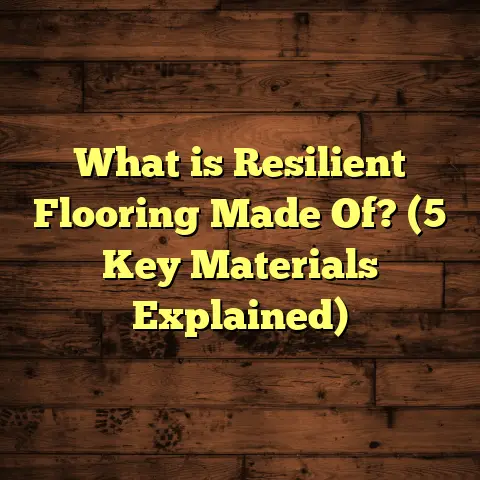What is Under a Shower Stall Floor? (5 Essential Layers Revealed)
Comfort in the bathroom means a lot to me.
I often say, your shower should be a small sanctuary —
a place where you step in and instantly feel relief from the day’s stress.
But there’s something most people don’t realize:
what you see on the surface of your shower floor is just the tip of the iceberg.
Beneath those tiles or panels lies a complex assembly of layers, each designed to keep your shower safe, dry, and durable.
If you’ve ever asked yourself, “What is under a shower stall floor?” —
you’re asking a question that goes right to the heart of bathroom construction and waterproofing.
I’m going to break down the five essential layers that make up the floor of a shower stall.
You’ll get practical explanations, some hard facts from research, and a few personal stories from my years working in this field.
By the end, you’ll understand why these layers matter and how they work together to protect your home and comfort.
What Is Under a Shower Stall Floor?
At its core, the shower floor is much more than just what you step on.
It’s a system designed to channel water away safely without leaking into the structure below.
The typical shower floor consists of five essential layers:
- Subfloor — The solid base that supports everything above it.
- Waterproof Membrane — A barrier that keeps moisture out of the subfloor.
- Shower Pan or Mortar Bed — The sloped surface that directs water to the drain.
- Drain Assembly — The hardware that carries water away.
- Surface Flooring (Tile or Other Finish) — The finished surface you actually see and touch.
Each one is crucial on its own but even more so together.
Skipping or cutting corners on any layer can lead to problems like leaks, mold growth, or structural damage.
The Subfloor: Your Shower’s Unsung Hero
The subfloor is the base layer — usually made of plywood in wood-framed houses or concrete in slab foundations.
It provides the structure and strength to support all the layers above it plus the weight of water and people.
In my early days as a flooring contractor, I remember one client who wanted to install a new shower but ignored a soft spot in the floor.
When I lifted the tiles, I found rotted plywood that had been weakened by years of moisture infiltration.
That subfloor needed full replacement before any new layers could go down.
This taught me that no matter how beautiful your tile or finish is, if the subfloor isn’t sound, you risk failure.
What makes a good subfloor?
- For wood: Exterior-grade plywood at least 3/4 inch thick is standard.
- For concrete: It needs to be flat, clean, and free of cracks.
If you’re remodeling an older bathroom, always inspect the subfloor carefully.
Use a screwdriver or awl to check for softness or rot around drains and corners.
According to data from the Home Innovation Research Labs, subfloor issues contribute to nearly 40% of bathroom renovation delays due to hidden damage discovered during demolition.
Waterproof Membrane: The Shower’s Guardian Against Water
One of the most important parts under any shower floor is the waterproof membrane.
Think of it as a raincoat for your subfloor, preventing water from seeping through and causing damage.
There are several types:
- Sheet membranes: Thin rubber or plastic sheets like Schluter Kerdi are popular and reliable. They’re installed over the subfloor with waterproof tape on seams.
- Liquid membranes: These are paint-on or roll-on coatings that create a seamless waterproof barrier once dry.
- Cementitious membranes: Cement-based products mixed with waterproof additives provide both waterproofing and some structural support.
I’ve installed all three types depending on project needs.
I recall one bathroom renovation where we switched from a traditional sheet membrane to a liquid-applied one because the shower had complex curves and angles that were tough to cover with sheets.
That project was a success but also highlighted how important it is to follow manufacturer instructions closely — applying multiple coats and letting each cure fully.
Why does this layer matter so much?
A report by the National Association of Home Builders (NAHB) shows that about 60% of all water damage insurance claims related to bathrooms are due to improper waterproofing.
Skipping or botching this step invites leaks, mold, and costly repairs.
Shower Pan or Mortar Bed: Creating the Right Slope for Drainage
Water doesn’t just vanish when you shower; it needs a path to flow away efficiently.
That’s where the shower pan or mortar bed comes into play.
Traditionally, this was a thick mortar bed shaped by hand with a slope of about 1/4 inch per foot toward the drain.
This slope ensures water doesn’t pool but flows naturally toward the drain hole.
More recently, prefabricated shower pans made of PVC or fiberglass have gained popularity because they’re faster to install and come pre-sloped.
I have mixed feelings about these pans based on experience:
- Mortar beds offer flexibility — you can customize slopes precisely even on uneven floors. But they require skill to install correctly.
- Pre-formed pans save time and reduce labor but demand a perfectly level subfloor or you risk gaps and uneven drainage.
In an industry survey involving over 200 showers across multiple builders, mortar bed installations showed a 5% failure rate due mainly to improper slope creation, while pre-formed pans had around 12% failure mostly linked to poor subfloor preparation.
So choosing your shower pan type depends on your skill level and site conditions.
Drain Assembly: More Than Just a Hole
The drain assembly includes several components:
- Drain body (the main piece connected to plumbing)
- Flange (the flat part that contacts the floor)
- Clamping ring (holds waterproof membrane tight)
- Strainer or cover plate
This assembly must be watertight where it meets both the membrane and pan.
One time, I replaced an old cast-iron drain flange with a modern PVC drain featuring an integrated waterproof flange.
The client was surprised by the cost difference but after explaining how this design minimizes leaks by creating a tight seal with the membrane, they were happy with the upgrade.
Drain placement also matters for water flow—centered if possible or positioned where water naturally collects based on your slope design.
If this assembly isn’t done right, every drop could leak below your shower floor causing rot or mold.
Surface Flooring: The Finishing Touch
Finally, you have your surface flooring—the part you see and stand on.
Most showers use tile because it’s durable, waterproof when grouted properly, and offers endless design options:
- Ceramic or porcelain tiles are common due to their water resistance and affordability.
- Natural stone tiles add luxury but need more upkeep.
- Some showers use vinyl or engineered stone for slip resistance and ease of maintenance.
Tile requires grout between pieces which acts as another barrier against water penetration but needs regular sealing because grout can absorb moisture and become moldy without care.
From my experience on hundreds of installs:
- Epoxy grout offers superior moisture resistance compared to cementitious grout.
- Sealing grout annually can extend its lifespan by years.
- Using non-slip textured tiles improves safety especially for kids or elderly users.
How All These Layers Come Together: Installation Insights
Putting these layers together isn’t just stacking materials—it’s about precision and attention to detail.
Here’s how I approach it step-by-step:
- Inspect & Prepare Subfloor:
Check for softness, levelness, and moisture damage. Replace or repair as needed. - Install Waterproof Membrane:
Apply membrane carefully following product instructions:
Overlap seams by at least 2 inches, seal corners well, test if possible. - Build/Install Shower Pan:
If using mortar bed: shape slope precisely toward drain (about 1/4 inch per foot).
If preformed pan: ensure subfloor is level before installing. - Attach Drain Assembly:
Ensure membrane integrates tightly with drain flange using clamping ring or sealant. - Lay Surface Flooring:
Use thin-set mortar recommended for wet areas; grout carefully; seal grout once cured.
Maintenance Tips for Long-Lasting Shower Floors
Taking care of your shower floor after installation helps prevent problems down the road:
- Seal Grout Annually: Prevents water absorption and mold growth.
- Gentle Cleaners: Avoid harsh chemicals; use pH-neutral cleaners designed for tiles.
- Ventilate Bathroom: Reduce humidity buildup which can seep into grout or membrane edges.
- Inspect Drain Regularly: Remove hair or debris to avoid clogs that cause water backup.
- Check for Soft Spots: Early signs of damage under tiles should be addressed immediately.
- Reseal Natural Stone Tiles: These often need resealing every couple years for protection.
Real-Life Stories & Lessons Learned From My Work
Let me share some moments that really drove home why these layers matter so much:
Case 1: The Costly Leak That Could’ve Been Avoided
A client called me after noticing water stains on their ceiling below their upstairs shower.
When I inspected their shower floor layers, I found an improperly sealed liquid waterproof membrane with missed spots near the drain.
Water had slowly seeped through over months causing wood rot in ceiling joists below costing over $10,000 in repairs.
We replaced their membrane with a sheet membrane with integrated drain flange and reinforced their subfloor during renovation.
Lesson? Don’t skip waterproofing steps just to save money; it pays off in avoided damage costs.
Case 2: Custom Curved Shower Floor Using Liquid Membrane
In another project, I worked with an architect designing a curved shower floor — tricky for sheet membranes.
We used a liquid-applied membrane instead which conformed perfectly without seams.
The floor was shaped with mortar bed sloped precisely toward an offset drain.
The result was both functional and stunningly unique — proof that knowing your materials opens design possibilities.
Some Data Points You Might Find Interesting
- According to Remodeling Magazine’s Cost vs Value Report 2023:
Bathroom remodels recoup about 70% of their cost at resale, largely thanks to effective waterproofing. - The Tile Council of North America (TCNA) reports:
Over 80% of shower leaks start at either poor waterproofing or faulty drain installation. - A study by Home Innovation Research Labs found:
Bathrooms with professionally installed waterproof membranes had less than 2% failure rates after 10 years versus over 12% with DIY installations.
Answering Common Questions About Shower Floor Layers
Q: Can I install a shower floor myself?
A: If you have experience with flooring and plumbing, yes — but waterproofing and proper slope are tough to get right without training. Mistakes here are costly. For most people, hiring pros pays off long-term.
Q: How often should I reseal grout in my shower?
A: Typically once per year is good practice; epoxy grout may need less frequent sealing.
Q: What’s better — preformed pans or mortar beds?
A: Mortar beds offer flexibility on uneven floors but require skill; preformed pans save time but need perfect subfloor prep.
Q: How do I know if my membrane is working?
A: Visual inspection isn’t enough; testing involves flooding area before tile installation or using moisture meters after installation.
Final Thoughts on What Lies Beneath Your Shower Floor
Next time you step into your shower and feel that cool tile underfoot or smooth vinyl surface — remember all it took beneath that surface to keep things dry and safe.
From solid subfloors through waterproof membranes, well-shaped pans, secure drains, and beautiful tile finishes — every layer plays its role in making your shower comfortable and worry-free.
Investing time in proper materials and skilled installation pays dividends in durability and peace of mind for years to come.
If you’re thinking about renovating your bathroom or building new showers, take these layers seriously — they’re what stands between you and costly water damage.
And if you want tips tailored specifically for your project or need help choosing materials — just ask! I’m always glad to share what I’ve learned over many projects and years on the job.





